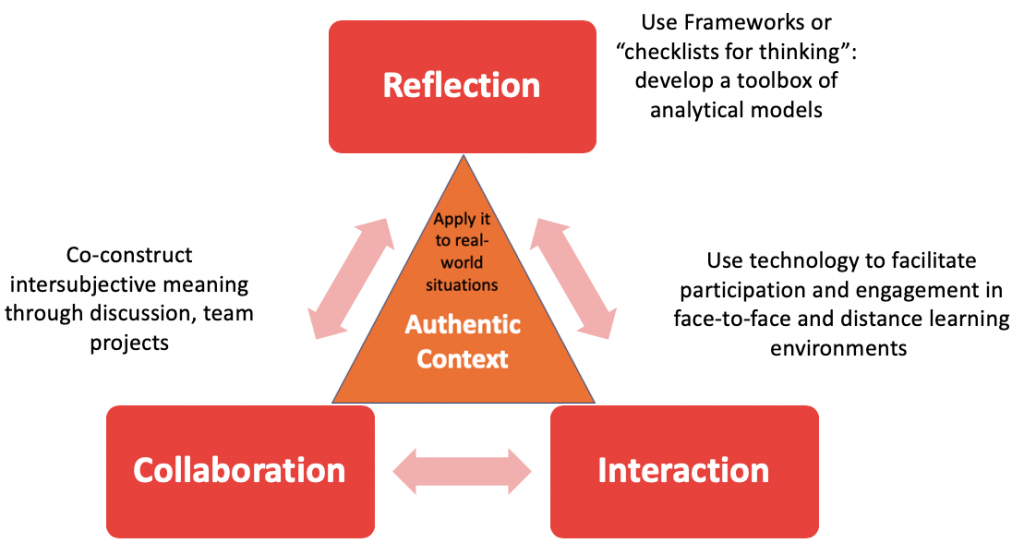At SKEMA Business School, we used the BrandPRO simulation platform coupled with a number of everyday tools such as a web browser and cell phones to promote active learning among students.
Collaborative Interactivity
Twenty-five centuries ago, Confucius is reputed to have said “I see, and I forget, I hear, and I remember, I do, and I understand”. Learning-by-doing goes under the many names: project-based learning, student-centric pedagogy, problem-based education. But how exactly do you get students to engage in active learning? In my doctoral thesis, I developed the concept of Collaborative Interactivity to capture the four attributes of any meaningful learning process.

Principles of Collaborative Interactivity
According to these premises, we must satisfy four interdependent conditions for students to “make sense” of what they learn. Firstly, they must be immersed in real-world problems. The context of learning must involve authentic, relevant scenarios they can clearly identify with. Students must share their insights with one another and co-construct solutions (collaboration) and they must have some degree of active control of the learning process (interaction). Technology can play an important role in both these dimensions. Finally, they need tools to structure their reflection process. In business education, these tools are often frameworks or “checklists for thinking” that help students apply the concepts they have learned following a sequence of ideas.
The BrandPRO Experience
Since 2018, we have applied these four principles in a discipline called “Marketing through Active Learning”. This discipline was about introducing Brand Management competencies to M1 students across 3 campuses through a simulation called BrandPRO by StratX, a French designer of online business serious games. Reflection in an authentic context
In order to provide over 1400 students with a common view of the concepts of Brand Management and the rules of the game, we prepared 6 hours of traditional lecture explaining brand management concepts and the rules of the game. To make these lecture hall sessions more participative, we used Kahoot!, a tool that allows teachers to gamify quizzes using students’ smartphones. Furthermore, we introduced a short 3-hour online course to explain how to prepare for the game and for the oral presentation at the end of the simulation. This initial setup helped students understand the concepts of segmentation, targeting and positioning in a realistic case of brand management.
Collaboration and Interaction
You cannot get 1400 students to collaborate unless you create very small groups. We created 330 groups of 4 or 5 students in our three French campuses: Lille, Paris and Nice (Sophia Antipolis). In each campus we trained 5 or 6 coaches to follow 10 teams over a one half-day period we called a “BrandPRO Hackathon”. Each member of the group were given a roles: Chief Executive Officer, the Chief Marketing Officer, Chief Design Officer and Product Manager (responsible for pricing decisions). Each role had their own designated space in the online tool, to simulate their decisions and observe the impact of their choices in the competitive environment. This instant interaction with the simulated world allowed students to learn from their mistakes and improve their performance from one round to the next. In order to facilitate communication among the 17 coaches, we created a Whatsapp channel to exchange real-time solutions to problems with the methodology or the technological infrastructure, while they led the groups through the simulated five-year period of the game. Conclusions and Lessons Learned
The BrandPRO experience combines the best of three different worlds: mass education in a lecture hall, e-learning and small-group collaboration. Indeed, after the short overview of Brand Management in a lecture hall, students could prepare to the simulation using the eLearning module we created, in order to be ready for the “hackathon” experience. Feedback from students included phrases like “it was great to play the role of a real decision maker” or “we could each focus on different parts of the problem and help each other find the best solution” or “we were busy trying to solve real-life problems all the time”.
In a sense, this project is a synthesis of the DNA of our Business School: highly digital (web-based technologies to facilitate learning and collaboration), global (students from several different nationalities) and innovative (combination of lecture halls, with e-Learning, with coaching sessions). But nothing can replace the enthusiasm of highly motivated teachers and coaches to give the whole experience a very human face. Here are a few lessons we learned:
- Create authentic learning environments by proposing case studies, scenarios, role playing, realistic projects to your students
- Traditional, lecture-based classes remain very effective to introduce concepts and frameworks that will facilitate reflection and interaction
- Use distance learning tools that allow students to prepare for the application of these concepts at their own speed in the comfort of their homes (further reflection, asynchronous interaction)
- Break students up in small groups to make them collaborate, interact and reflect around the authentic problems using the prepared tools.






